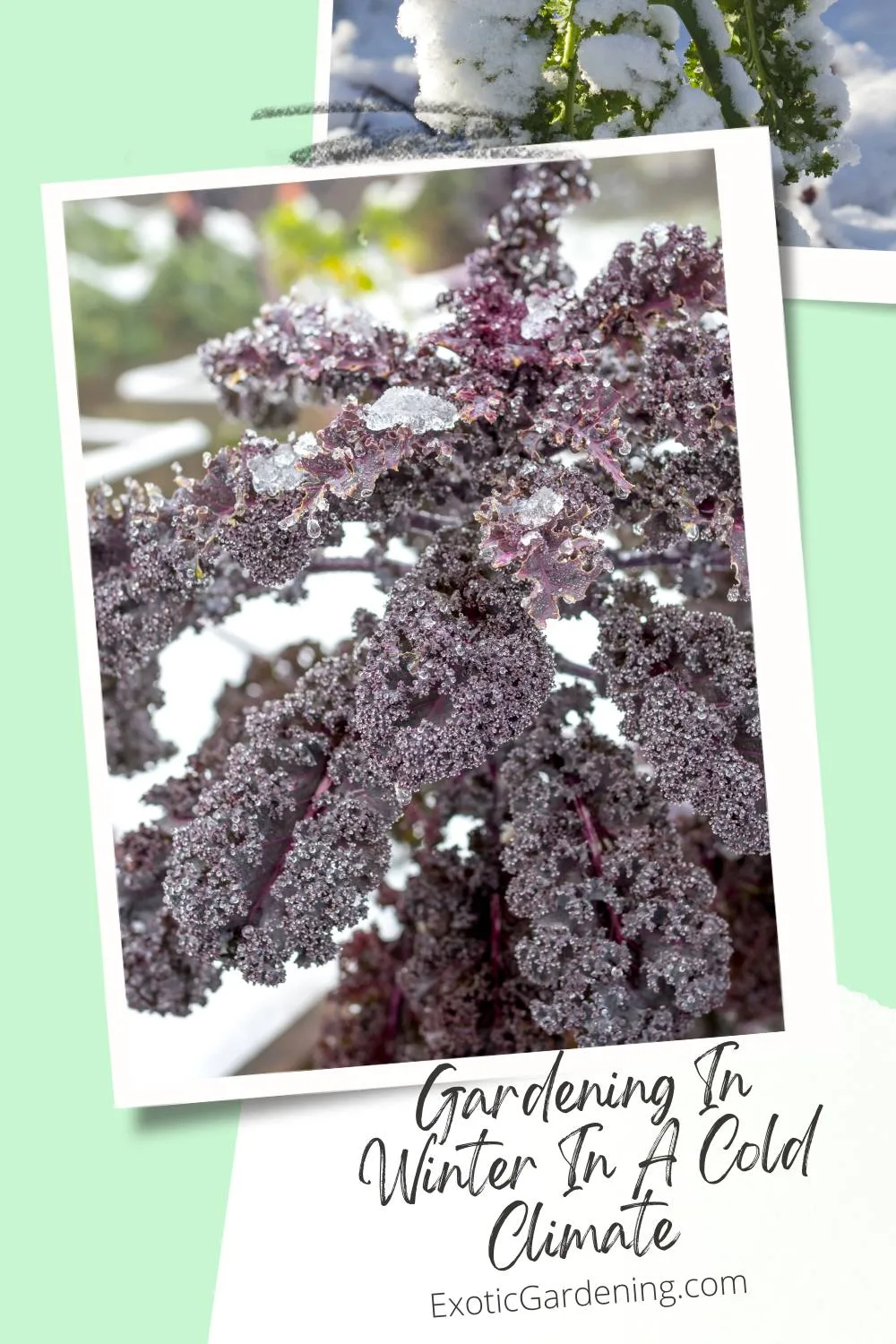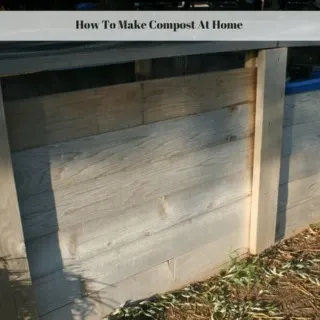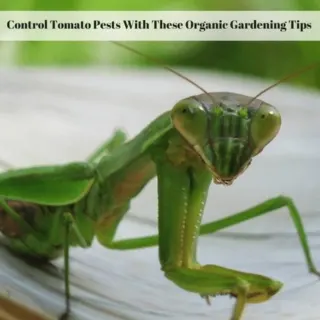Gardening in winter in a cold climate outdoors is possible if you are willing to grow cool weather crops and protect those crops with frost cover, cold frames or a similar structure.
It is a cold, snowy 16 degrees F here today however it is January 1 and I am harvesting and planting vegetables in my Indiana garden.
Below I share my tips on how I harvest and plant all year long.

Gardening In Winter In A High Tunnel
My little unheated high tunnel is not in a protected area.
Behind it are the towers of the city water company however we get really strong crosswinds because of their open field being right across the street.
Last fall I planted some Wakefield Cabbage in there as well as some lettuce, spinach, snow peas and radish seed.
The lettuce and spinach seed did not germinate for some reason, but the radish seed germinated and grew just fine.
On January 1, I harvested fresh radish from inside the high tunnel.

Adding Additional Layers Of Protection
I did use frost cover inside of the high tunnel but I did not get the bottoms and ends secured to the ground.
If I had done that plus put an extra layer of 6 mil. plastic over the top of the frost cover, I am sure the harvest would have been better.
Some of the smaller radish were frozen and soft, so I put those in the compost pile.
The cabbages faired pretty well, although I suspect they will bolt come spring, however that is ok because I will let them set seed so I can save it to plant later this summer when I start the plants for my fall and winter garden.
The best thing about saving the seed is it is adapted to my climate which means the plants grown from it are going to do better in my garden.
One huge mistake I made was closing the high tunnel up too early last fall which meant the inside was much warmer than what cool crops like it.
I was in a hurry and not really thinking about venting it on warm days.
That caused some plants to bolt early because it was much too warm inside the plastic.
Working In The Winter Garden Care
After harvesting the radishes and pulling up any tiny weeds that were trying to sprout, I used my handy circle hoe to work the top of the ground.
The soil was quite dry and easy to work which is always nice.
The next thing I did was water the raised beds.
I did not drench the soil, I just gave it a gentle watering with a watering can.
The top half inch or so of the soil needs to be damp enough that the seeds begin to germinate.
In another couple of days, I will go back out and give the soil another sprinkling of water.
It is important to make sure the soil stays moist anytime you are trying to germinate seeds.
The established plants need enough moisture to thrive, but not so much that they end up water logged.
Learning exactly how often to water and how much water to apply is essential to winter gardening success.
My rule of thumb is to apply just enough water to wet the top inch or so of soil and not to water again until that soil begins to look - and feel - dry.

What To Grow When Gardening In Winter
This year I made two beds inside this high tunnel.
One is half filled with cabbage and the other half of that bed is where the radish are.
I left one bed unplanted.
I chose seeds from Renee's Garden to plant in that bed.
I planted Romeo Round Baby Carrots and Asian Baby Leaf Gourmet Mesclun Salad.
Both of these should do fine.
Here are a few other vegetables that should overwinter just fine inside a cold frame or high tunnel.
- salad greens
- spinach
- kale
- Swiss Chard
- Brussels sprouts
- radishes
- potatoes
I do not expect the seeds will germinate immediately, but once the weather outside begins to warm up the inside of the high tunnel is going to get warm enough to encourage the seeds to sprout.
This means I am going to be harvesting these crops several weeks before it is warm enough to plant these same crops outside without protection.

Additional Information
I am located in Indiana, which is USDA Hardiness Zone ⅚.
With a little protection is is possible to have a year-round garden, even in a cold climate.
Gardening during the winter months has many advantages such as no pests plus the ability to harvest fresh cool season crops from your own garden instead of buying them at the store and paying a premium price.
Want know more?
Then check out The Complete Idiot's Guide To Year-Round Gardening by Sheri Ann Richerson and Delilah Smittle.
Planting Your Garden
How Much To Plant In Your Garden
This article will help you figure out how much to plant in your garden depending on your family's size and whether you want to preserve the food or not.
When to Plant in Spring: Early Season Garden Tips
Know when to plant in spring by using these early garden season tips. These tips will allow you to get a head start on your vegetable garden.
Benefits Of Container Gardening During Changeable Weather Conditions
Changeable weather conditions certainly impacts gardeners who wish to grow their plants in the ground, but there is a solution. Learn about the benefits of container gardening and how it can help gardeners deal with climate change!
How To Grow Tomatoes
Learn how to grow tomatoes and how to plant tomatoes in a garden. Growing great tomatoes is easy if you follow a few simple steps.
Mastering Sweet Potato Gardening: How to Plant Sweet Potato Plants
Unlock the secrets of successful gardening with our guide on how to plant sweet potato plants for a bountiful harvest!
Gardening Tips For Beginners
These gardening tips for beginners will help you get your first garden started right. Tips on gardening planning, caring for bareroot plants and more.
How To Garden In Winter Indoors And Outdoors
Learn how to garden in winter indoors and outdoors. There are many vegetables and herbs that don't mind the cold or thrive in containers.
How To Make Compost At Home
Learn how to make compost at home using materials you already have on hand and are likely to throw into the trash and send to the local landfill.
Control Tomato Pests With These Organic Gardening Tips
These organic gardening tips for controlling pests on tomato plants help you identify, control and get rid of the problem without the use of organic pesticides in most cases.
How To Combat Blossom End Rot
Wondering what to do about tomatoes with brown spots on the bottom of them? Learn how to combat blossom end rot, a common problem many gardeners encounter.
Save Money! Harvest Free Vegetables Year-Round In Any Climate!
Garden tips for beginners - and advanced gardeners alike - that are sure to help save money. These gardening tips are about more than just plant care!
Vegetable Growing Realities: More Than Economic Benefits
When it comes to the facts of vegetable growing realities, there are more reasons than just the economic benefits for doing it.
Outsmart Frost in Spring Vegetable Gardens
Understanding how to outsmart frost in spring vegetable gardens leads to earlier harvests, less plant damage and a longer growing season.
Greenhouse And Coldframe Garden Structure Ideas
Learn about tunnel houses, greenhouses and cold frame garden structures as well as how they are used to grow plants outdoors year round.
Vegetable Garden Tips And Ideas For Using Artificial Grass
If you're looking for vegetable garden tips and ideas that incorporate the use of artificial grass, look no further! Weed prevention, pest control and environmental benefits. If you're looking for vegetable garden tips and ideas that incorporate the use of artificial grass, look no further! Weed prevention, pest control and environmental benefits.
10 Easiest Vegetables to Grow from Seed
Learn about the 10 easiest vegetables to grow from seed. Not only are there some unique heirloom varieties, but they are tasty too!
Extend the Spring Vegetable Garden
Learn how to extend the spring vegetable garden into summer, fall or even winter by using various shading and covering techniques.
Survival Food Garden: Grow Vegetables For Disaster Preparedness
A survival food garden is a great thing to have even if you don't believe the zombie apocalypse is coming.
Peanuts Are Exotic Plants: Growing vegetables such as peanuts can make your garden unique
It is possible to learn how to grow peanuts even if you don't live in a warm climate. Peanuts are exotic plants that are fun to grow.
Plant A Row For The Hungry: Feed The Hungry By Donating Extra Garden Produce
Plant A Row For The Hungry encourages gardeners to plant extra vegetables and donate them to their local food pantries to help those in need.
What Garden Seeds To Plant In June
There are a number of vegetable garden seeds to plant in June. Even if the soil is too wet to work, there are ways around that.
Eat Better, Save Money By Growing A Garden
Learn how you can eat better and save money by growing a garden right in your own backyard or even on your balcony!
Sheri Ann Richerson
Growing organically is important because the produce is healthier and contains more nutrients.
It is better for the environment, insects and birds, plus there is no concern about the potential issues with GMO’s.
It is also environmentally friendly and helps reduce your carbon footprint, not to mention saves money.
Plus there is the holistic perspective of growing an organic garden because from the soil to the food we eat, it is all interconnected.
In this course you will learn:
How to build healthy organic soil
When to plant seeds or established plants as well as when to direct sow
How to simplify garden maintenance
Natural methods of pest control





























